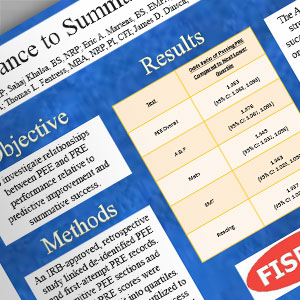ABSTRACTS
Predicting the End: Entrance to Summative Exam Predictive ValueAuthor: Alycia Brantz-Miller MS, NRP | | Sanford Health Associate Authors: Rollman, Jeffrey, MPH, NRP | Khalsa, Sahaj, BS, NRP | Martens, Eric A, BS, EMPA, NRP | Dworak, Mason, BA, EMT-B | Morgan, Whitney, MS, NRP | Berry, Jennifer, BA | Fentress, Thomas L, MBA, NRP, PI, CFI | Dinsch, James, MS, NRP, CCEMTP
Introduction Accreditation standards pressure paramedic programs to admit students most likely to succeed. Programs failing to meet retention levels risk being cited among other consequences. Therefore, it is critical for programs to understand how best to predict student success. The Fisdap Paramedic Entrance Exam (PEE) and Paramedic Readiness Exam (PRE) version 3 measure knowledge at program start and end. The PEE assesses baseline knowledge in four cognitive areas–anatomy and physiology (A&P), EMT, mathematics, and reading comprehension–and several affective domains. PRE evaluates summative knowledge. Objective To investigate relationships between PEE and subsequent PRE performance relative to predictive improvement and summative success. Methods An IRB-approved, retrospective study linked de-identified PEE and first-attempt PRE records from Fisdap (an online EMS database). Cognitive PEE sections and overall PRE scores were individually split into quartiles. A cut score of 73 was used to calculate odds of PRE success with quartile-based PEE overall and section performance using ordered logistic regression analysis. Results In all, 1,185 students met inclusion criteria for analysis. The ordered logistic regression determined each successive higher quartile had significantly increased odds of passing the PRE3: PEE overall (OR=1.083, 95% CI: 1.068-1.098), A&P (OR=1.076, 95% CI: 1.061-1.091), Math (OR=1.045,95% CI: 1.032-1.058), EMT (OR=1.043, 95% CI: 1.029-1.056), Reading (OR=1.037, 95% CI: 1.024-1.050). Discussion The A&P section of the PEE had the strongest association with student success on the PRE. Poor performance on the PEE is not a definitive predictor of students’ likelihood of passing the PRE. Grouping students into quartiles based on PEE scores and tracking PRE completion demonstrated substantial mobility of students between quartiles. A&P was most predictive of PRE success. Conversely, reading was least predictive of PRE success. Conclusion The PEE offers predictive value to summative PRE performance. The PEE should be included as part of a multi-faceted selection process rather than a singular selection criteria.
|

